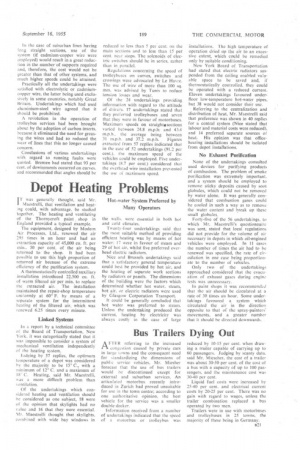Depot Heating Problems
Page 55

If you've noticed an error in this article please click here to report it so we can fix it.
Hot-water System Preferred by Many Operators
I T was generally thought, said Mr. Maestrelli, that ventilation and heating could, with advantage, be studied together. The heating and ventilating of the Thornycroft paint shop in England provided a typical example.
The equipment, designed by Modern Air Processes, Ltd., renewed the air 295 times in an hour and had an extraction capacity of 45,000 Cu. ft. per min., 50 per cent. of the air being returned to the shop. It had been possible to use this high proportion of returned air because of the extreme efficiency of the purification system.
A thermostatically controlled auxiliary installation introduced 22,500 cu. ft. of warm filtered air per min. to replace the extracted air. The installation maintained the repair-shop temperature uniformly at 60° F. by means of a separate system for the intermittent heating of the filtered air, which was renewed 6.25 times every minute.
Linked Systems
In a report by a technical coinmittee of the Board of Transportation, New York, it was categorically stated that it was impossible to consider a system of mechanical ventilation independently of the heating system. Judging by 57 replies, the optimum temperature of a depot was considered by the majority to be 15° C., with a minimum of 12° C. and a maximum of 18' C. Heating, said Mr. Maestrelli, was a more difficult problem than ventilation.
Of the undertakings which considered heating and ventilation should be considered as one subject, 18 were of the opinion that skylights had no value and 16 that they were essential. Mr. Maestrelli thought that skylights, combined with wide bay windows in the walls, were essential in both hot and cold climates.
Twenty-four undertakings said that the most suitable method of providing efficient heating was by means of hot water; 17 were in favour of steam and 29 of hot air, whilst five preferred overhead electric radiators.
Nice and Brussels undertakings said that a satisfactory general temperature could best be provided by hot air, and the heating of separate work sections by radiators or panels. The dimensions of the building were the factors which determined whether hot water, steam, hot air, or electric radiators were used by Glasgow Corporation Transport.
It could be generally concluded that hot water was preferred to steam. Unless the undertaking produced the current, heating by electricity was always costly in the case of large installations. The high temperature of operation dried tip the air to an excessive extent, which could be remedied only by suitable conditioning.
New York Board of Transportation had stated that electric radiators suspended from the ceiling enabled valuable space to be saved and, if thermostatically controlled, they could be operated with a reduced current. Eleven undertakings favoured underfloor low-temperature hot-water pipes, but 38 would not consider their use.
Referring to the centralization and distribution of heat, Mr. Maestrelli said that preference was shown in 40 replies for a central system (Nice stated that labour and material costs were reduced). and 14 preferred separate sources of heat. His opinion was that officeheating installations should be isolated from depot installations.
No Exhaust Purification
None of the undertakings consulted used devices for purifying products of combustion. The problem of smoke purification was extremely important. and a system should be employed to remove sticky deposits caused by soot globules, which could not be removed by water alone. It was generally considered that combustion gases could be cooled in such a way as to remove the water content and break up these small globules.
Forty-five of the 56 undertakings. to which Mr. Maestrelli's questionnaire was sent, stated that local regulations did not provide for the volume of air necessary in depots in which oil-engined vehicles were employed. hi 11 cases the number of times the air had to be renewed was specified, the rate of circulation in one case being proportionate to the number of vehicles.
Only two of the undertakings approached considered that the evacuation of exhaust gases during engine tests was unnecessary.
In paint shops it was recommended that the air should be circulated at a rate of 30 times an hour. Some undertakings favoured a system which circulated the air in the direction opposite to that of the spray-painters' movements, and a greater number that it should be directed downwards.




































































































